Centenary Diamond
Open FREE Unlimited Store Join Our Newsletter
Dr. Shihaan M. Lariff
Origin of Name
The Centenary diamond gets its name from the centenary of the De Beers Consolidated Mines Ltd. celebrated on March 11, 1988. 1888 was the year the English entrepreneur Cecil Rhodes incorporated De Beers Consolidated Mines Ltd. The Centenary rough diamond was actually discovered on July 17, 1986, at the Premier diamond mines, but all those involved in the discovery were sworn to silence. The closely guarded secret of the De Beers Mining Company was unveiled to the world only on March 11, 1988, at a special banquet held to mark the centenary and attended by dignitaries of diamond-producing countries, and companies involved in various aspects of the diamond industry and trade. The Chairman of the company Mr. Julian Oglivie Thompson, who delivered the welcoming speech on this occasion, wanted to give an element of surprise to his distinguished audience, and reserved the disclosure of his well-guarded secret until the tail-end of his speech. Accordingly the final statement of his speech was, "We have recovered at the Premier Mine a rough diamond of 599 carats which is perfect in color - indeed it is one of the largest top-color diamonds ever found. Naturally it will be called the Centenary Diamond." The Chairman's closing remarks was greeted by a wild round of applause, and the rough diamond discovered in 1986 was christened the "Centenary Diamond". Not only was this an appropriate moment to reveal the long kept secret of the Company, but the name chosen for the new discovery was also the most appropriate.
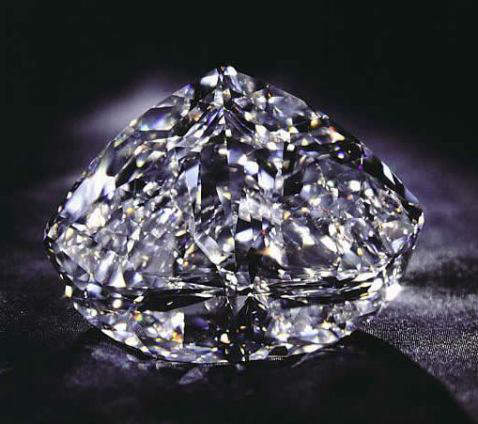
273.85-carat, D-color, Internally Flawless, Modified Heart-Shaped Centenary Diamond
© De Beers Group
Characteristics of diamond
The 599-carat top-color rough diamond is the 3rd-largest rough diamond ever recovered from the Premier Diamond Mine
The Centenary rough diamond discovered in the De Beers Premier Diamond Mine on July 17, 1986, using the latest electric X-ray imaging system, was a 599-carat top-color rough diamond, the third largest rough diamond ever recovered from the Premier Diamond Mine, after the 3106-carat Cullinan rough diamond discovered in 1905 and the 755-carat Golden Jubilee rough diamond discovered in 1985. As of year 1986, the 599-carat Centenary rough diamond was the 15th largest rough diamond ever discovered in the world. See table below :-
According to this table the Centenary diamond occupies the 17th position. However, two diamonds above this, were discovered after 1986. They are the Millennium star rough diamond discovered in 1990 and the Lesotho Promise discovered in 2006. If we subtract two positions the Centenary diamond at the time of discovery in 1986, would be the 15th-largest rough diamond ever discovered.
List of largest gem-quality rough diamonds discovered in the world as at year 2011
Name |
Country of discovery | Year of discovery | Carat Weight | Color | Position |
| Cullinan | South Africa | 1905 | 3,106 | Colorless/White | 1 |
| Excelsior | South Africa | 1893 | 995 | Colorless /White | 2 |
| Star of Sierra Leone | Sierra Leone | 1972 | 969.80 | Colorless/White | 3 |
| Incomparable | Zaire | 1984 | 890 | Brownish-yellow | 4 |
| Great Mogul | India | 1650 | 787 | Colorless/White | 5 |
| Millennium Star | Zaire | 1990 | 777 | Colorless/White | 6 |
| Woyie River | Sierra Leone | 1945 | 770 | Colorless/White | 7 |
| Golden Jubilee | South Africa | 1985 | 755 | Yellowish-brown | 8 |
| President Vargas | Brazil | 1938 | 726.60 | Colorless/White | 9 |
| Jonker | South Africa | 1934 | 726 | Colorless/White | 10 |
| Jubilee-Reitz | South Africa | 1895 | 650.80 | Colorless/White | 11 |
| Unnamed | South Africa | 1984 | 620.14 | 12 | |
| Sefadu | Sierra Leone | 1970 | 620 | Colorless/White | 13 |
| Kimberley Octahedral | South Africa | 1964 | 616 | Yellow | 14 |
| Lesotho Promise | Lesotho | 2006 | 603 | Colorless/White | 15 |
| Lesotho Brown | Lesotho | 1967 | 601 | Brown | 16 |
| Centenary | South Africa | 1986 | 599 | Colorless/White | 17 |
| De Grisogono | Central Africa | Probably in the 1950s | 587 | Black | 18 |
| Letseng Star | Lesotho | 2011 | 553 | Colorless/White | 19 |
| Unnamed Petra Diamond | South Africa | 2009 | 507 | Colorless/White | 20 |
| Letseng Legacy | Lesotho | 2007 | 493 | Colorless/White | 21 |
| Light of Letseng | Lesotho | 2008 | 478 | Colorless/White | 22 |
| Jacob-Victoria | South Africa | 1884 | 457.50 | Colorless/White | 23 |
| Zale light of peace | Sierra Leone | 1969 | 435 | Colorless/white | 24 |
| De Beers | South Africa | 1888 | 428.50 | Yellow | 25 |
| Niarchos | South Africa | 1954 | 426.50 | Colorless/White | 26 |
©internetstones.com
Please do not copy our tables without our permission. We may be compelled to inform the search engines if our content and tables are plagiarised.
Characteristics of the rough diamond
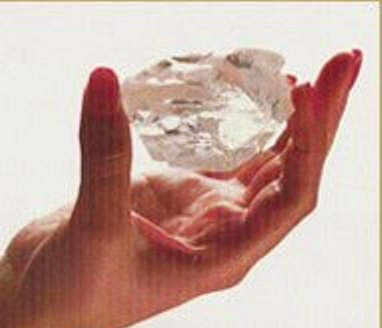
The Centenary Rough Diamond
The Centenary diamond was a 599-carat top-color rough diamond. In it's rough form the Centenary diamond resembled an irregular match box with angular planes, a prominent horn like structure jutting out at one corner and a deep concave on the largest flat surface. Thus the shape of the stone itself presented some serious problems to any experienced cutter who would attempt to cut it.

Gabi Tolkowsky examining the rough Centenary diamond
The 4Cs of the cut and polished diamond
The cut and polished Centenary diamond is a 273.85-carat, D-color diamond with a modified heart-shape. The unique feature of the stone is it's exceptional clarity, and the stone has been graded as internally flawless (IF). The dimensions of the diamond are 50.50 x 39.90 x 24.55 mm. The stone has a total of 247 facets, 164 on the crown and the pavilion, and 83 around the girdle.
The Centenary Diamond is a Type IIa diamond
The Centenary diamond, being a D-color diamond is a Type IIa diamond, free of nitrogen and all other chemical impurities. They are also structurally perfect diamonds, without any plastic distortions. Thus factors that usually cause color in diamonds are absent, and therefore these diamonds are absolutely colorless. The diamonds are said to be chemically pure and structurally prefect. However, they constitute only about 1-2 % of all naturally occurring diamonds.
The Centenary diamond is perhaps the largest faceted D-color internally and externally flawless diamond in the world
The Centenary diamond is perhaps the largest, faceted, D-color, internally as well as externlly flawless diamond in the world. The veracity of this statement is subject to the assumption that the Cullinan I and II diamonds,which are above the Centenary diamond in the table below, are not internally flawless, being true. The clarity of Cullinan I and II diamonds are not known exactly, and most of the literature available on the Cullinan diamonds mention only about the remarkable clarity of the Cullinan rough diamond before cutting, and the black spot in the middle of the diamond. Unfortunately, the clarity grades of the Cullinan satellite diamonds after cutting, seem to have been overlooked by all the available literature, and hence the use of the word "perhaps" to qualify the above statement.
The Centenary diamond is undoubtedly the 3rd-largest faceted D-color diamond in the world
According to the list of famous D-color diamonds given below, the Centenary diamond is undoubtedly the 3rd-largest, faceted, D-color diamond in the world. It is also the largest modified-heart shaped diamond in the world, and perhaps the only modified heart-shaped diamond in the list of famous diamonds greater than 100 carats in weight. See the second table given below.
List of famous D-color diamonds over 100 carats in weight
S/N |
Name | Carat Weight | Shape/Cut |
| 1 | Cullinan I | 530.20 | pear |
| 2 | Cullinan II | 317.40 | cushion |
| 3 | Centenary | 273.85 | modified heart |
| 4 | Jubilee | 245.35 | cushion |
| 5 | Millennium Star | 203.04 | pear |
| 6 | La Luna | 200.07 | heart |
| 7 | Orlov | 189.62 | rose |
| 8 | Jacob-Victoria | 184.50 | oval |
| 9 | Regent | 140.64 | cushion |
| 10 | Paragon | 137.82 | 7-sided |
| 11 | Premier Rose | 137.02 | pear |
| 12 | Queen of Holland | 135.92 | cushion |
| 13 | Zale Light of Peace | 130.27 | Pear |
| 14 | Niarchos | 128.25 | Pear |
| 15 | Portuguese | 127.02 | asscher |
| 16 | Jonker | 125.35 | emerald |
| 17 | Al-Nader | 115.83 | pear |
| 18 | Taj-i-Mah | 115.06 | moghul |
| 19 | Edna Star | 115.00 | emerald |
| 20 | Koh-i-Nur | 108.93 | oval |
| 21 | Mouawad Magic | 108.81 | emerald |
| 22 | Cartier | 107.07 | pear |
| 23 | Star of Egypt | 105.51 | emerald |
| 24 | Mouawad Splendor | 101.84 | pear |
| 25 | Star of America | 100.57 | asscher |
| 26 | Star of Happiness | 100.36 | radiant |
| 27 | Star of the Season | 100.10 | pea |
©internetstones.com
The Centenary diamond is perhaps the 7th-largest faceted diamond in the world
The following table is a "comprehensive" list of 68 known faceted famous diamonds in the world greater than 100 carats arranged in descending order of weights. The table was painstakingly collated by our staff after collecting all available information. The list may not be entirely comprehensive as some diamonds might have been inadvertently omitted or due to lack of precise information. We have tried our best to make the list all inclusive. The list will be revised as more information on other new diamonds are received.
According to this list, the 273.85-carat Centenary diamond occupies the 7th-position, which means it is the 7th-largest faceted diamond in the world. The Centenary diamond comes immediately after the 312.24-carat Spirit of de Grisogono diamond, the 6th-largest diamond, and also the 2nd-largest black diamond in the world.
List of Famous Diamonds Greater than 100 carats in weight arranged in descending order of weights
S/N |
Name | carat weight | shape/cut | color |
| 1 | Golden Jubilee | 545.67 | cushion | fancy yellow-brown |
| 2 | Cullinan I | 530.20 | pear | colorless/white |
| 3 | Unnamed Black Diamond | 489.07 | rectangular-cut | black |
| 4 | Incomparable | 407.48 | shield shaped | fancy brownish yellow |
| 5 | Cullinan II | 317.40 | cushion | colorless/white |
| 6 | Spirit of de Grisogono | 312.24 | old moghul-cut | black |
| 7 | Centenary | 273.85 | modified-heart | colorless/white |
| 8 | Oppenheimer | 253.70 | natural octahedral | yellow |
| 9 | Jubilee | 245.35 | cushion | colorless/white |
| 10 | De Beers | 234.65 | cushion | light yellow |
| 11 | Red Cross | 205.07 | cushion | canary yellow |
| 12 | Millennium Star | 203.04 | pear | colorless/white |
| 13 | Unnamed | 200.87 | pear | yellow |
| 14 | La Luna | 200.07 | heart-shaped | colorless/white |
| 15 | Orlov | 189.62 | rose-cut | colorless/white |
| 16 | Darya-i-Nur | 186 | table-cut | light pink |
| 17 | Jacob-Victoria | 184.50 | oval | colorless/white |
| 18 | Moon | 183 | round | pale yellow |
| 19 | Unnamed | 180.85 | briolette | yellow |
| 20 | Star of Peace | 170.49 | pear | brownish-yellow |
| 21 | Table of Islam | 160.18 | emerald-cut | black |
| 22 | Unnamed | 150.00 | emerald | yellow |
| 23 | Regent | 140.64 | cushion | colorless/white |
| 24 | Paragon | 137.82 | 7-sided | colorless/white |
| 25 | Florentine | 137.27 | double rose-cut | light yellow |
| 26 | Premier Rose | 137.02 | pear | colorless/white |
| 27 | Algeiba Star | 135.03 | square-brilliant | yellow |
| 28 | Sarah | 132.43 | cushion | fancy vivid yellow |
| 29 | Golden Hue | 132.42 | cushion | yellow |
| 30 | Tiffany Yellow | 128.54 | cushion |
canary yellow |
| 31 | Star of the South | 128.48 | cushion | fancy light pinkish-brown |
| 32 | Niarchos | 128.25 | pear | colorless/white |
| 33 | Portuguese | 127.02 | asscher | colorless/white |
| 34 | Jonker | 125.35 | emerald | colorless/white |
| 35 | Stewart | 123.00 | round-brilliant | yellow |
| 36 | Delaire Sunrise | 118.08 | square emerald-cut | fancy vivid yellow |
| 37 | Meister | 118.00 | cushion | yellow |
| 38 | Vainer Briolette | 116.60 | briolette | fancy light yellow |
| 39 | Hope of Africa | 115.91 | cushion | fancy vivid yellow |
| 40 | Al-Nader | 115.83 | pear | colorless/white |
| 41 | Gruosi Diamond | 115.34 | heart-shaped | black |
| 42 | Taj-i-Mah | 115.06 | moghul-cut | colorless/white |
| 43 | Edna Star | 115.0 | emerald | colorless/white |
| 44 | Unnamed | 114.64 | briolette | yellow |
| 45 | Unnamed | 114.03 | cushion | yellow |
| 46 | Mouna | 112.50 | cushion | fancy intense yellow |
| 47 | African Yellow | 112.00 | yellow | |
| 48 | Earth Star | 111.59 | pear | brown |
| 49 | Cross of Asia | 109.26 | radiant | light brown |
| 50 | Koh-i-Noor | 108.93 | oval | colorless/white |
| 51 | Mouawad Magic | 108.81 | emerald | colorless/white |
| 52 | Anon | 108.04 | emerald | yellow |
| 53 | Rojtman | 107.46 | cushion | yellow |
| 54 | Cartier | 107.07 | pear | colorless/white |
| 55 | Golden Sun | 105.54 | emerald | yellow |
| 56 | Star of Egypt | 105.51 | emerald | colorless/white |
| 57 | Golden Door | 104.95 | pear | yellow |
| 58 | Geat Chrysanthemum | 104.61 | pear | fancy brown |
| 59 | Graff Constellation | 102.79 | round brilliant | colorless/white |
| 60 | Ashberg | 102.48 | cushion | dark orange yellow/amber |
| 61 | Mouawad Splendour | 101.84 | pear | colorless/white |
| 62 | The Alnatt | 101.29 | cushion | fancy vivid yellow |
| 63 | The Golden Star | 101.28 | cushion | fancy vivid yellow |
| 64 | Star of America | 100.57 | asscher | colorless/white |
| 65 | Sunrise | 100.52 | emerald | yellow |
| 66 | Star of Happiness | 100.36 | radiant | colorless/white |
| 67 | Star of the Season | 100.10 | pear | colorless/white |
| 68 | Graff Vivid Yellow | 100.09 | cushion | fancy vivid yellow |
©internetstones.com
History
History of De Beers Consolidated Mines Ltd.
Discovery of diamonds in South Africa in the mid-1860s and the subsequent opening of the Kimberley and De Beers Mines
Diamonds were first discovered in Southern Africa in the mid-1860s on the farm belonging to Nicolas and Diederick de Beer, near what is now the city of Kimberly. Two diamond mines known as the Kimberley and the De Beers were opened on this farm, and eventually became the world's most productive diamond mines. The actual mining took place at a hill in the farm called Colesberg Kopple, where the miners dug intensively, along the course of a diamond bearing pipe (now known as Kimberlites). The Kimberley mine was named after the first Earl of Kimberley, who was then the British Colonial Secretary. The town of Kimberley was erected in 1878, and incorporated into the Cape Colony in 1880.

Johannes Nicholas De Beer

1868 Carte de Visite of Right Honourable John Wodehouse, 1st Earl of Kimberley - British Colonial Secretary from 1870 to 1874 and 1880-1882, after whom the town of Kimberley and the Kimberley Dimond Mine were named
Photo by - John Watkins
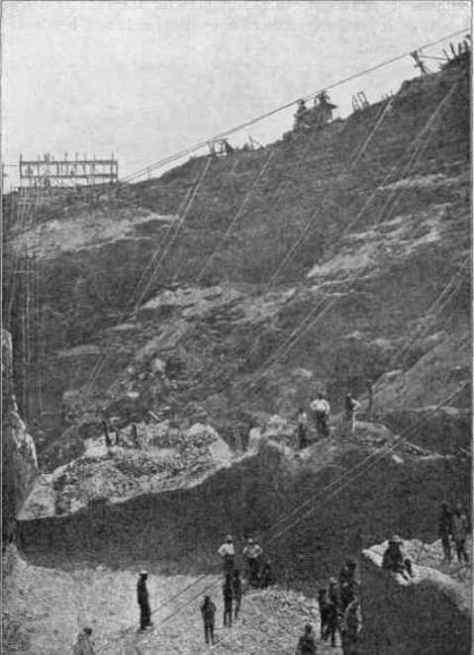
A section of the Kimberley Mine in 1874
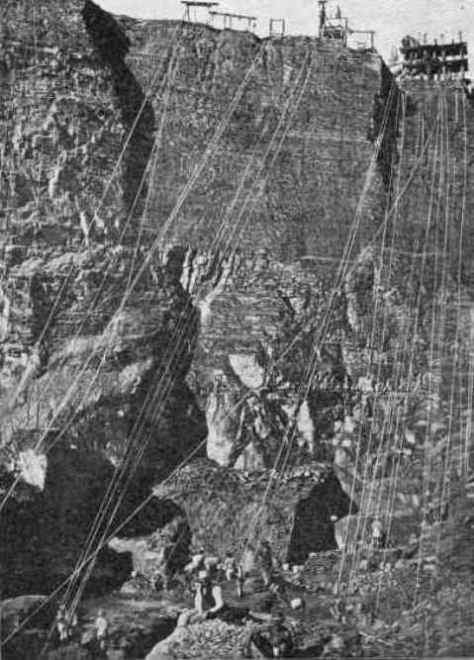
Section of the De Beers Mine in 1874
Investment by the English Entrepreneur Cecil Rhodes in 1871, and the eventual acquisition of most of the diamond mines in South Africa. Incorporation of De Beers Consolidated Mines Ltd. on March 11, 1888
In 1871, the English entrepreneur Cecil Rhodes invested and obtained a claim in the De Beers mines. With the expansion of his investment Rhodes was eventually able to purchase most of the diamond mines in South Africa. On March 11, 1888, Rhodes incorporated De Beers Consolidated Mines Ltd. By mid 1890s, Rhodes had established the Diamond Syndicate with a view of controlling the word diamond distribution, in order to keep prices high and demand steady. The Diamond Syndicate was the forerunner of today's Central Selling Organization, that controls much of the world's trade in diamonds.

Cecil Rhodes founder of the De Beers Company and Prime Minister of the Cape Colony from 1890 to 1896
Ernest Oppenheimer, founder of Anglo-American Corporation of Namibia, becomes Chairman of De Beers Consolidated Mines Ltd. in 1929, leading to a partnership that explored the diamond mines of South Africa and Namibia and controlled the world diamond trade
In 1917, Ernest Oppenheimer founded the Anglo-American Corporation, which took control of the diamond mines in South-West Africa (Namibia), and created a new diamond syndicate. In 1926, Oppenheimer bought a seat on the De Beers board and became it's Chairman 3-years later. Since then De Beers Consolidated Mines Ltd. has been closely associated with the Anglo-American Corporation of South Africa, in exploring the diamond mines of Southern Africa and Namibia, and controlling the world diamond trade.
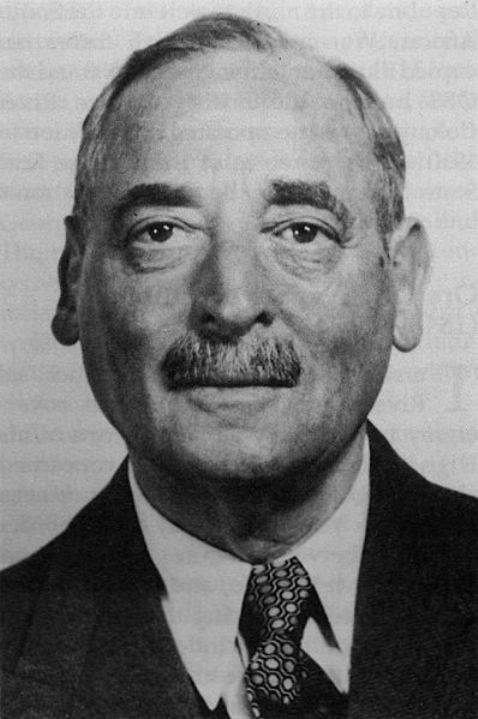
Sir Ernest Oppenheimer - Diamond and Gold Mining Entrepreneur who took control of De Beers in 1929
Discovery of the Premier diamond mine in Transvaal, South Africa 1902, where the world's largest diamond weighing 3,106 carats was discovered in 1905
Another important diamond mine, that was discovered in South Africa in 1902 by Sir Thomas Cullinan, was the Premier mine, situated in Transvaal, South Africa. It was in this mine the world's largest diamond weighing 3,106 carats in the rough state, was discovered in 1905, and was appropriately named the Cullinan Diamond. This massive colorless diamond was purchased by the Transvaal Government, and presented in 1907 to the reigning British Monarch, King Edward VII. Since then the Premier diamond mines has produced some outstanding diamonds such as the Niarchos in 1954, the Taylor-Burton in 1966, and the Premier Rose in 1978.
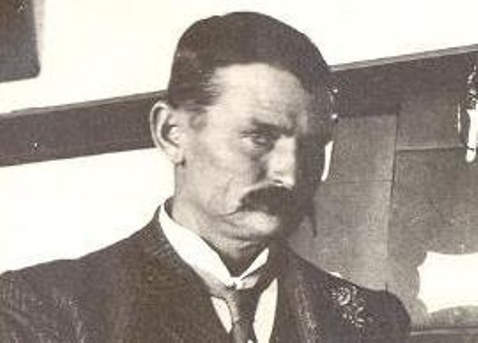
Sir Thomas Cullinan - Original Owner of the Premier Diamond Mine
De Beers Consolidated Mines Ltd acquired a controlling interest in the Premier diamond mine in 1917, and later after World War II acquired the mine fully, beginning underground mining operations in 1945
The ownership of the Premier mines was subsequently acquired by the De Beers Consolidated Mines Ltd. and under it's management became one of the most productive mines in the world. In 1917, De Beers Consolidated Mines that controlled several mines in the Kimberley region of Northern Cape Province of South Africa, acquired a controlling interest in the Premier Diamond Mine. Production at the Premier mine was disrupted during the outbreak of the 1918 worldwide flu pandemic, known as Spanish Flu. Production was again disrupted during the great depression of the 1930s and later the second World War. De Beers Consolidated acquired the mine fully in 1945, soon after World War II, and production resumed immediately afterwards. The mine which was operated hitherto as an open pit mine, now began underground mining operations, and under the management of De Beers Consolidated became one of the most productive mines in the world. The Premier mine is also the source of several high quality colored diamonds, including the very rare blue diamonds. The eleven exceptional quality blue diamonds that constituted the De Beers Company's limited edition Millennium Diamonds Collection, that was exhibited at the Millennium Dome, throughout the year 2000 were all sourced from the Premier diamond mines.
The Cutting and Polishing of the Centenary Diamond
De Beers Company commissioned a team of experts headed by Gabi Tolkowsky to evaluate the rough Centenary and recommend the most appropriate cut/cuts to be adopted
The next important step was the difficult task of cutting the rough centenary diamond to produce either a single faceted diamond or several smaller diamonds, keeping in mind the three cardinal principles of diamond cutting, viz. maximizing for brilliance, maximizing for color, and maximizing for yield. This required the skill and expertise of experienced and accomplished cutters in the diamond industry. The De Beers mining company commissioned a team of experts and world renowned master cutters, headed by Gabi Tolkowsky, a world renowned diamond cuter, hailing from a family of diamond cutters, with five new diamond cuts to his credit, to evaluate the rough Centenary, and to recommend the most appropriate techniques and designs, to be adopted, and subsequently to undertake the actual cutting of the stone. Others in the team included Geoff Woolett, Jim Nash, and Dawie du Pleiss, all accomplished diamond cutters.
Initial recommendation of the team of experts was to keep the rough diamond in tact to produce a single large modern-cut diamond and to remove the protruding horn, superficial cracks and flaws, before deciding on the actual shape/cut of the diamond
After a careful and extensive examination of the rough centenary using the most sophisticated electronic and other equipment at their disposal, the team recommended that the Centenary be kept in tact to produce one single large modern-cut diamond. But, before the actual shape and design of the stone could be recommended, the team decided to eliminate the protruding horn, the large cracks at the edge of the stone, and other superficial flaws.
A specially designed room was created in the De Beers Diamond Research Laboratory in Johannesburg inside which the cutting and polishing of the diamond was to be carried out
A hand picked team of engineers, electricians, and security guards were also co-opted by the company to assist in this project. A specially designed underground room in the De Beers Diamond Research Laboratory in Johannesburg, was set up, with the sole purpose of working on the Centenary diamond. Design specifications for this room included the strength and stability of the materials used, in order to prevent mechanical vibrations and temperature variations, thereby minimizing any mitigating factor that might interfere with the cutting of the Centenary diamond.
Removal of cracked material and other superficial flaws was achieved by the traditional time-consuming method of hand kerfing,that resulted in a roughly egg-shaped stone
With everything in place, the team set about, with the difficult task of cutting the stone. The team decided not to use laser or saw for the initial steps of the cutting, to remove cracked material and other superficial defects. This was done to prevent the heating and vibrating of the diamond. Instead they adopted the traditional method of kerfing by hand, a process that is slow and time consuming. It took the team 154 days, to cut and remove 50 carats of cracked material. After this was completed they were left with a roughly egg-shaped stone weighing about 520 carats.
13 different designs that would suite the egg-shaped stone were presented to the De Beers board with a strong recommendation for one design the modified heart-shape which was accepted
Having successfully accomplished the initial steps in the cutting process, the team embarked on the difficult task of taking accurate measurements, and drawing appropriate designs, that may possibly suit the egg-shaped stone. The team finally presented 13 different designs to the De beers board, with a strong recommendation in respect of one design, viz. the modified heart-shape. The Board accepted the modified heart-shape as it's choice, and then the final process of faceting the Centenary began in March 1990.
The cutting and polishing of the diamond was completed in 10 months resulting in the breathtakingly beautiful, modified heart-shaped, internally flawless, 273.85-carat Centenary Diamond
The faceting was finally completed after nearly 10 months of painstaking work in February 1991. After the completion of the cutting, the centenary diamond had a weight of 273.85 carats and dimensions of 39.90 × 50.50 × 24.55 mm. The diamond with the modified heart-shape had a record 247 facets, 164 on the crown and pavilion and 83 around it's girdle. This was the first time such a large number of facets had been created for a diamond, and the breathtaking effect of this was visible even to the casual observer. This was in line with Gabi Tolkowsky's belief that adding facets meant adding more mystery and reaction to the journey of light in the diamond. The GIA color grading for the diamond is D-color, which is the highest grade for colorless diamonds, and the clarity is internally flawless (IF). In addition to the Centenary, two other flawless, pear-shaped smaller diamonds, weighing 1.47 and 1.41 carats were also cut from the rough.
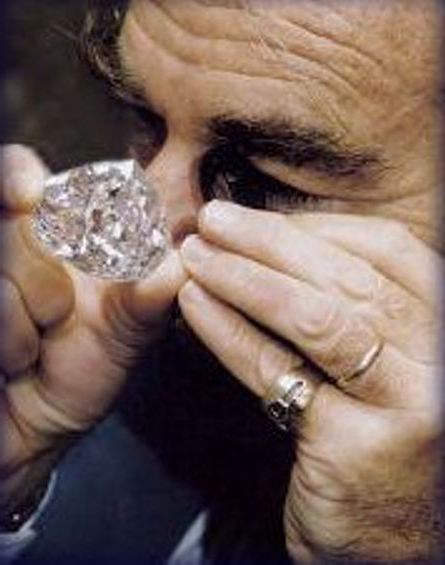
Gabi Tolkowsky Examining the Centenary Diamond with a Jeweler's Loop
The value of the Centenary Diamond? Has the Centenary Diamond been disposed of by De Beers?
While the Centenary diamond has never been appraised for it's value, it is known to have been insured for around US$100 million, at the time of it's unveiling in May 1991. The stone was later loaned to the Tower of London, where it was displayed for a number of years. Whether De Beers still owns the Centenary, or whether the stone has been disposed of is still a mystery. Gabi Tolkowsky has said that he believes that the gem has been sold, but De beers declines any comment, citing it's policy of anonymity.
Reflections of the Legendary Master Diamond Cutter Gabi Tolkowsky from a lecture delivered to GIA students at the Carlsbad Campus in California
Gabi Tolkowsky addressing GIA students at the Carlsbad Campus during a visit to GIA on June 5, 2006, said, "the task of a diamond cutter is to make the dull, unpleasant appearance of a diamond so beautiful that it contains bags of gold in its heart,' by creating and applying different styles of facet patterns to the combined natural shape and volume of the rough diamond. This is exactly what he had done with the 599-carat Centenary rough diamond, creating a new cut/shape known as the modified heart-shape and adding extra facets to bring out the full potential beauty of the diamond.
Elaborating on the evolution of the diamond cuts starting with the 19-faceted table-cut,
Mazarin, Perruzzi, Brazilian, Old Mine, Old European, and Old Oval cuts until the development of the modern briliant cuts, to the development of which his uncle Marcel Tolkowsky had immensely contributed,
He said, "many artists throughout time realized that adding facets meant adding more mystery and reaction to the journey of light in the diamond. He further said, Every diamond you touch is an individual, like you. No diamond will ever act the same. He said, "I speak to the diamond when cutting: What do you want to become? I ask" and provide the answer: the most beautiful!
In conclusion the world renowned master diamond cutter said, "Just like a computer, you file all what you learn from each diamond, you file it, you file it inside your brain and then, you use your imagination and one day, you compose and a new cut, a new beauty is born! The tiny, small touches of the craftsman the artist cutter are extremely beneficial. That is the fantastic life of a diamond cutter!
Gabi Tolkowsky was also involved in the cutting of the 755-carat Golden Jubilee rough diamond that metamorphosed into a beautiful, 545.67-carat, yellow brown, cushion-cut brilliant, the largest faceted diamond in the world
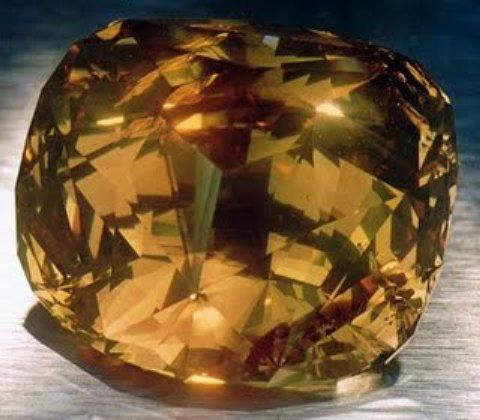
545.67-carat Golden Jubilee Diamond - the Largest Faceted Diamond in the World
Gabi Tolkowsky was also involved in the cutting of the 755-carat Golden Jubilee rough diamond, the large yellow brown diamond, also discovered in the Premier diamond mines in 1985, just one year before the discovery of the Centenary diamond. In fact it has been said that the Golden Jubilee rough was used by the De Beers Company, to test a series of modern tools and equipment developed by the company for the processing of larger diamonds. Not only did the tested equipment pass all the stringent conditions of the test, but the enormous rough diamond also metamorphosed into a beautiful, 545.67-carat, yellow brown, cushion-cut brilliant, taking the unique position held by the 530.20-carat Cullinan I diamond, as the largest faceted diamond in the world, a position which it held for over 80 years. After the success of the cutting of the Golden Jubilee, Gabi Tolkowsky and his team embarked on the more challenging task of cutting the Centenary diamond.
You are welcome to discuss this post/related topics with Dr Shihaan and other experts from around the world in our FORUMS (forums.internetstones.com)
Related :-
External Links :-
Legendary Master Diamond Cutter Gabi Tolkowsky Addresses GIA Students
References :-
1) Centenary diamond - From Wikpedia, the free encycllopedia
2) The Centenary - www.famousdiamonds.tripod.com
3) GIA Newsroom - Gabi Tolkowsky Addresses GIA students
4) Cecil Rhodes - From Wikipedia, the free encyclopedia
5) Sir Ernest Oppenheimer - From Wikipedia, the free encylopedia
Powered by Ultra Secure
Amazon (USA) Cloud Network

Founder Internet Stones.COM
Register in our Forums
| Featured In
|
|
|
|
|
|
|
|


















